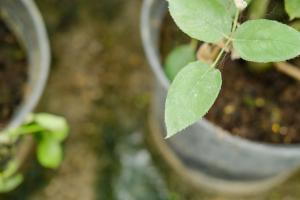How to Stake Tomato Plants in Containers
Growing your own tomatoes can be a great way to enjoy fresh produce from your own garden. If you are growing tomatoes in containers, you will need to stake them to keep them upright and healthy. Staking tomato plants helps to improve air circulation around the plants, reduce the risk of disease, and makes harvesting the fruit easier. In this article, we will guide you through the steps to stake tomato plants in containers.
Choose the Right Stake
The first step in staking tomato plants is to choose the right stake. The stake should be at least six feet tall, and made of a sturdy material such as bamboo, metal, or wood. It is important to choose a stake that will not bend or break under the weight of the plant, as this will not provide the necessary support. You can find tomato stakes at your local garden center, or you can make your own using materials such as PVC pipe or rebar.
Plant the Tomato
Once you have chosen your stake, you can plant your tomato. When planting a tomato in a container, make sure to choose a container that is at least 18 inches deep and 24 inches wide. Fill the container with a good quality potting soil that is rich in nutrients. Dig a hole in the center of the container, and plant the tomato seedling. Water the plant thoroughly, and wait for it to grow to a height of about six inches before staking.
Stake the Tomato
When the tomato plant reaches a height of six inches, it is time to stake it. Place the stake into the soil beside the tomato, and gently tie the stem of the plant to the stake using a soft, flexible material such as garden twine or strips of fabric. You want to ensure that the tie is secure, but not too tight, as this can damage the stem. As the tomato plant grows taller, continue to tie it to the stake every six to eight inches, using additional ties or clips as necessary.
Prune the Tomato
In order to encourage healthy growth and a higher yield of fruit, it is important to prune your tomato plant. Pruning involves removing the side shoots that grow between the main stem and the branches. These side shoots, known as suckers, compete with the main stem for nutrients and can reduce the overall health of the plant. Use a sharp pair of pruning shears to remove the suckers when they are small, before they grow too large and start to produce flowers or fruit.
Water and Fertilize the Tomato
Finally, it is important to water and fertilize your tomato plant regularly. Tomatoes require consistent moisture to thrive, so make sure to water the plant deeply once or twice a week, depending on the weather conditions. Fertilize the plant every two to three weeks with a balanced fertilizer that is high in phosphorus and potassium. This will help to promote healthy growth, strong root development, and a high yield of fruit.
Conclusion
Staking tomato plants is a simple but important step in growing healthy and abundant tomatoes. By following the steps outlined in this article, you will be able to stake your tomato plant and enjoy a bountiful harvest of fresh, delicious tomatoes all season long. Happy gardening!

 how many times do yo...
how many times do yo... how many planted tre...
how many planted tre... how many pine trees ...
how many pine trees ... how many pecan trees...
how many pecan trees... how many plants comp...
how many plants comp... how many plants can ...
how many plants can ... how many plants and ...
how many plants and ... how many pepper plan...
how many pepper plan...





























